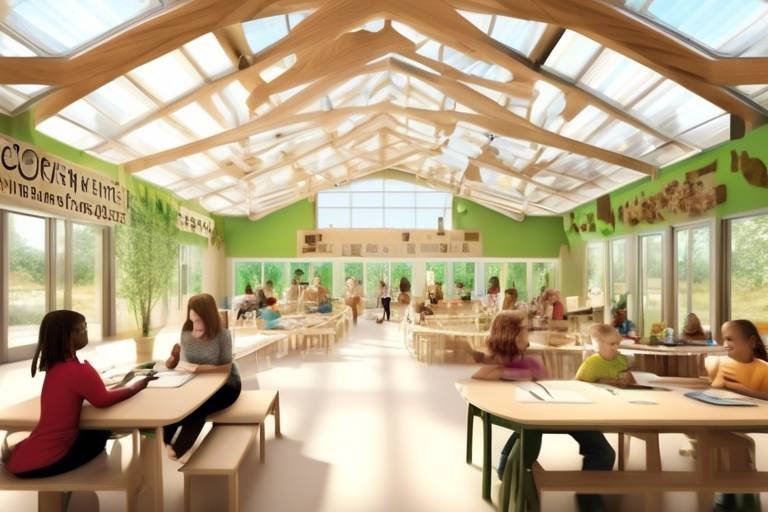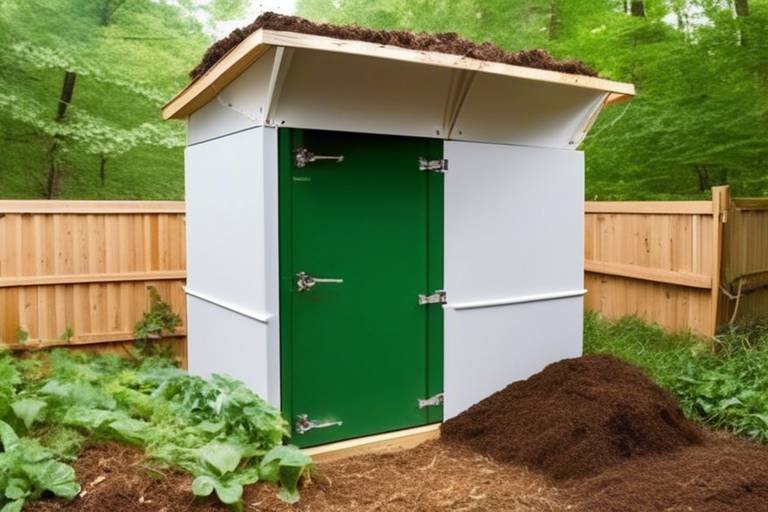How to Create an Eco-Friendly Community Center
Creating an eco-friendly community center is a noble endeavor that requires careful planning and consideration of sustainable practices. From the location selection to the design elements, every step plays a crucial role in building a space that not only benefits the environment but also fosters a sense of community and sustainability.
When choosing the location for your community center, prioritize sites that are easily accessible by public transportation and have ample green spaces. Opting for a location close to renewable energy sources can also help reduce the center's carbon footprint and promote eco-friendly commuting options for visitors.
Energy-efficient design is key to minimizing the environmental impact of the community center. Incorporating solar panels, energy-efficient LED lighting, and proper insulation can significantly reduce energy consumption and operating costs, making the center more sustainable in the long run.
Water conservation strategies are essential for promoting sustainable water management practices within the community center. Installing water-saving fixtures, implementing rainwater harvesting systems, and using drought-resistant landscaping can help reduce water usage and minimize the center's impact on local water resources.
Utilizing recycled materials in the construction and furnishing of the community center is not only environmentally friendly but also promotes a circular economy. By giving new life to materials that would otherwise end up in landfills, you can showcase the importance of sustainable resource management to the community.
Enhancing the aesthetic appeal of the community center while promoting environmental benefits can be achieved through green roofs and sustainable landscaping. Native plants not only beautify the surroundings but also improve air quality, reduce the urban heat island effect, and support local biodiversity.
Effective waste management and recycling programs are vital for minimizing waste generation and promoting a culture of sustainability within the community. Implementing recycling initiatives, composting facilities, and educating visitors on proper waste disposal practices can help create a greener and cleaner environment for all.
Engaging the community in eco-friendly initiatives and providing educational programs on sustainability are key components of creating a truly eco-friendly community center. By fostering a sense of environmental responsibility and encouraging active participation, you can inspire individuals to make positive changes in their daily lives for the benefit of the planet.
Seeking certifications such as LEED or following green building standards can validate the eco-friendly features of the community center and attract environmentally conscious users. By showcasing your commitment to sustainability, you can contribute to a more eco-conscious future and inspire others to follow suit.

Location and Site Selection
This article explores sustainable practices and design elements essential for establishing an environmentally conscious community center. From renewable energy sources to green building materials, learn how to create a space that promotes eco-friendly living and community engagement.
Choosing the right location for a community center is crucial in fostering sustainability. Opting for a site with easy access to public transportation not only reduces the carbon footprint of visitors but also encourages the use of eco-friendly commuting options. Additionally, selecting a location with ample green spaces promotes biodiversity and provides a natural environment for community members to enjoy.

Energy-Efficient Design
This article explores sustainable practices and design elements essential for establishing an environmentally conscious community center. From renewable energy sources to green building materials, learn how to create a space that promotes eco-friendly living and community engagement.
Choosing a site with access to public transportation, green spaces, and renewable energy sources is crucial for creating an eco-friendly community center that minimizes its environmental impact.
Implementing energy-efficient solutions like solar panels, LED lighting, and proper insulation can significantly reduce the community center's energy consumption and carbon footprint.
Incorporating water-saving fixtures, rainwater harvesting systems, and drought-resistant landscaping can help conserve water resources and promote sustainable water management practices.
Utilizing recycled materials for construction and furnishing the community center not only reduces waste but also promotes a circular economy and sustainable resource management.
Installing a green roof and using native plants in landscaping not only enhances the aesthetic appeal of the community center but also improves air quality, reduces urban heat island effect, and supports local biodiversity.
Implementing effective waste management strategies, such as recycling programs and composting facilities, can help minimize waste generation and promote a culture of sustainability within the community.
Engaging the community in eco-friendly initiatives and providing educational programs on sustainability can foster a sense of environmental responsibility and encourage active participation in creating a greener community.
Seeking certifications like LEED or following green building standards can validate the eco-friendly features of the community center, attract environmentally conscious users, and contribute to a more sustainable future.

Water Conservation Strategies
Water conservation is a critical aspect of creating an eco-friendly community center. By incorporating various strategies, you can effectively manage water resources and promote sustainability within the facility. One key approach is the use of water-saving fixtures such as low-flow toilets and faucets. These fixtures help reduce water consumption without compromising functionality, contributing to significant water savings over time.
Additionally, implementing rainwater harvesting systems can further enhance water conservation efforts. By collecting rainwater from the roof of the community center, you can use it for irrigation, flushing toilets, and other non-potable purposes. This not only reduces the demand for municipal water but also helps prevent stormwater runoff, which can contribute to water pollution.
Furthermore, incorporating drought-resistant landscaping is essential for minimizing water usage in outdoor areas. By selecting native plants that are well-adapted to the local climate and require less water, you can create a sustainable landscape that thrives without excessive irrigation. This not only conserves water but also promotes biodiversity and ecosystem resilience.
Integrating smart irrigation systems equipped with weather sensors can also optimize water usage by adjusting irrigation schedules based on real-time weather conditions. This ensures that plants receive the right amount of water at the right time, reducing water waste and promoting efficient water management practices.
Overall, by combining water-saving fixtures, rainwater harvesting systems, drought-resistant landscaping, and smart irrigation technologies, you can establish a water-efficient community center that prioritizes sustainability and environmental stewardship.

Use of Recycled Materials
When it comes to creating an eco-friendly community center, the use of recycled materials plays a vital role in promoting sustainability and reducing environmental impact. By incorporating recycled materials in the construction and furnishing of the center, you not only contribute to waste reduction but also support a circular economy where resources are reused efficiently.
Recycled materials can range from reclaimed wood and metal to repurposed glass and plastic. These materials not only add a unique and eclectic aesthetic to the community center but also showcase a commitment to environmental responsibility. Utilizing recycled materials also helps in reducing the demand for new resources, thereby lowering the carbon footprint associated with manufacturing new products.
Moreover, incorporating recycled materials can inspire creativity and innovation in design, as the limitations posed by working with reclaimed materials often lead to unique and sustainable solutions. From furniture made of upcycled pallets to decorative elements crafted from salvaged materials, the use of recycled materials can add character and charm to the community center while promoting sustainability.
It is essential to source recycled materials from reputable suppliers and ensure that they meet quality standards for structural integrity and safety. By choosing high-quality recycled materials, you can create a community center that not only reflects a commitment to sustainability but also stands the test of time.

Green Roof and Sustainable Landscaping
This article explores sustainable practices and design elements essential for establishing an environmentally conscious community center. From renewable energy sources to green building materials, learn how to create a space that promotes eco-friendly living and community engagement.
Choosing a site with access to public transportation, green spaces, and renewable energy sources is crucial for creating an eco-friendly community center that minimizes its environmental impact.
Implementing energy-efficient solutions like solar panels, LED lighting, and proper insulation can significantly reduce the community center's energy consumption and carbon footprint.
Incorporating water-saving fixtures, rainwater harvesting systems, and drought-resistant landscaping can help conserve water resources and promote sustainable water management practices.
Utilizing recycled materials for construction and furnishing the community center not only reduces waste but also promotes a circular economy and sustainable resource management.
When it comes to creating an eco-friendly community center, incorporating a green roof and sustainable landscaping can offer a myriad of benefits. A green roof not only enhances the aesthetic appeal of the building but also serves as a natural insulator, reducing the need for artificial heating and cooling. By using native plants in landscaping, the community center can support local biodiversity and provide habitats for wildlife. Additionally, the presence of greenery helps improve air quality, reduces the urban heat island effect, and promotes a sense of tranquility and well-being among visitors.
Implementing effective waste management strategies, such as recycling programs and composting facilities, can help minimize waste generation and promote a culture of sustainability within the community.
Engaging the community in eco-friendly initiatives and providing educational programs on sustainability can foster a sense of environmental responsibility and encourage active participation in creating a greener community.
Seeking certifications like LEED or following green building standards can validate the eco-friendly features of the community center, attract environmentally conscious users, and contribute to a more sustainable future.

Waste Management and Recycling Programs
This article explores sustainable practices and design elements essential for establishing an environmentally conscious community center. From renewable energy sources to green building materials, learn how to create a space that promotes eco-friendly living and community engagement.
When it comes to creating an eco-friendly community center, waste management and recycling programs play a crucial role in minimizing environmental impact and promoting sustainability. By implementing effective waste management strategies, such as recycling programs and composting facilities, the community center can significantly reduce waste generation and foster a culture of environmental responsibility within the community.
Recycling programs not only help divert waste from landfills but also promote resource conservation by reusing materials in a closed-loop system. By segregating recyclable materials such as paper, plastic, glass, and metal, the community center can contribute to a more sustainable waste management approach.
Composting facilities can further enhance waste reduction efforts by converting organic waste into nutrient-rich compost that can be used to enrich the soil in community gardens or landscaping projects. This not only reduces the amount of organic waste sent to landfills but also promotes soil health and supports sustainable gardening practices.
Engaging the community in recycling and composting initiatives can also raise awareness about the importance of waste reduction and resource conservation. By providing educational programs and workshops on waste management, the community center can empower individuals to make environmentally conscious choices and actively participate in creating a greener community.
Furthermore, incorporating visible recycling bins and signage throughout the community center can encourage proper waste sorting and disposal, making it easier for visitors to participate in recycling efforts. By making recycling a convenient and accessible option, the community center can instill a culture of sustainability and environmental stewardship among its users.
In conclusion, waste management and recycling programs are essential components of an eco-friendly community center, helping to minimize waste, conserve resources, and promote a sustainable lifestyle. By implementing these initiatives, the community center can lead by example and inspire positive environmental change within the community.

Community Engagement and Education
Community engagement and education play a vital role in fostering a sustainable mindset within the community and promoting active participation in eco-friendly initiatives. By organizing workshops, seminars, and interactive sessions, the community center can educate individuals on the importance of environmental conservation and sustainable practices. These educational programs can cover a wide range of topics, including renewable energy, waste reduction, water conservation, and the benefits of using eco-friendly products.
Furthermore, involving the community in hands-on projects such as community gardens, tree planting initiatives, and recycling drives can instill a sense of ownership and responsibility towards maintaining a green environment. By encouraging participation in these activities, the community center can create a strong bond among residents, fostering a shared commitment to sustainability.
Collaborating with local schools, environmental organizations, and businesses can also enhance community engagement and provide additional resources for educational programs. By forming partnerships with various stakeholders, the community center can expand its reach and impact, creating a network of support for sustainable initiatives.

Certifications and Green Building Standards
This article explores sustainable practices and design elements essential for establishing an environmentally conscious community center. From renewable energy sources to green building materials, learn how to create a space that promotes eco-friendly living and community engagement.
Choosing a site with access to public transportation, green spaces, and renewable energy sources is crucial for creating an eco-friendly community center that minimizes its environmental impact.
Implementing energy-efficient solutions like solar panels, LED lighting, and proper insulation can significantly reduce the community center's energy consumption and carbon footprint.
Incorporating water-saving fixtures, rainwater harvesting systems, and drought-resistant landscaping can help conserve water resources and promote sustainable water management practices.
Utilizing recycled materials for construction and furnishing the community center not only reduces waste but also promotes a circular economy and sustainable resource management.
Installing a green roof and using native plants in landscaping not only enhances the aesthetic appeal of the community center but also improves air quality, reduces urban heat island effect, and supports local biodiversity.
Implementing effective waste management strategies, such as recycling programs and composting facilities, can help minimize waste generation and promote a culture of sustainability within the community.
Engaging the community in eco-friendly initiatives and providing educational programs on sustainability can foster a sense of environmental responsibility and encourage active participation in creating a greener community.
Seeking certifications like LEED or following green building standards can validate the eco-friendly features of the community center, attract environmentally conscious users, and contribute to a more sustainable future.
Frequently Asked Questions
- What are the benefits of creating an eco-friendly community center?
Creating an eco-friendly community center offers numerous benefits, including reducing environmental impact, promoting sustainable practices, and fostering a sense of environmental responsibility within the community. It can also lead to cost savings through energy efficiency and waste reduction.
- How can location and site selection impact the sustainability of a community center?
The location and site selection of a community center play a crucial role in its sustainability. Choosing a site with access to public transportation, renewable energy sources, and green spaces can minimize the center's carbon footprint, encourage eco-friendly transportation options, and enhance the overall environmental quality of the area.
- What are some key energy-efficient design elements that can be incorporated into a community center?
Energy-efficient design elements such as solar panels, LED lighting, natural ventilation systems, and high-efficiency HVAC systems can help reduce energy consumption, lower utility costs, and contribute to a healthier indoor environment for occupants.
- How can community engagement and education contribute to the success of an eco-friendly community center?
Engaging the community in eco-friendly initiatives and providing educational programs on sustainability can create a sense of ownership and pride among residents. It fosters a culture of environmental stewardship, encourages sustainable behaviors, and strengthens the bond between the community and the center.



















